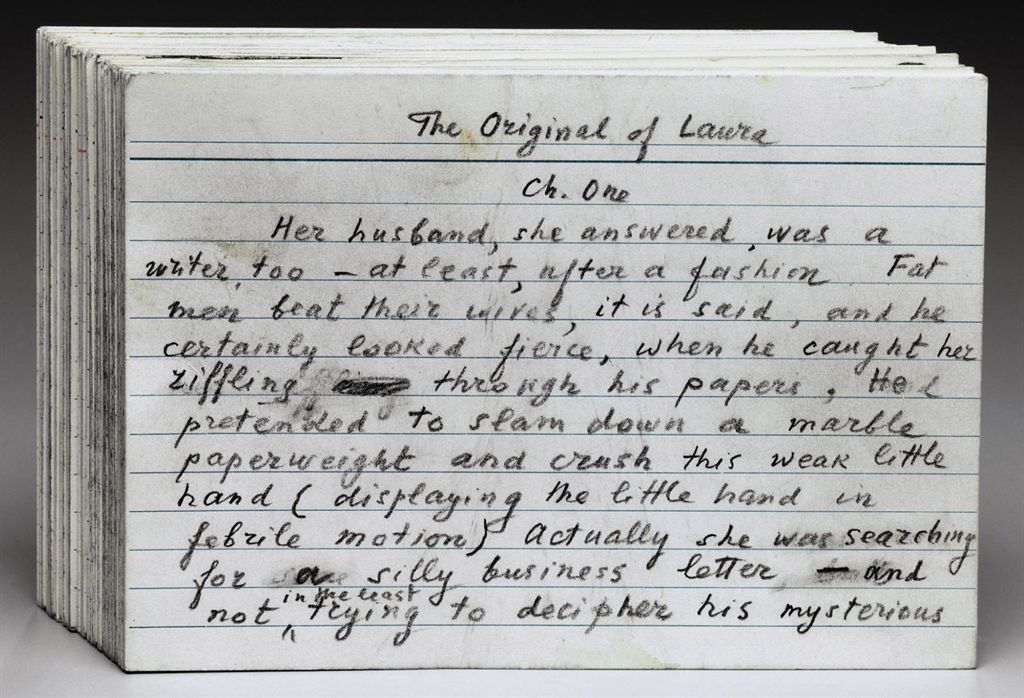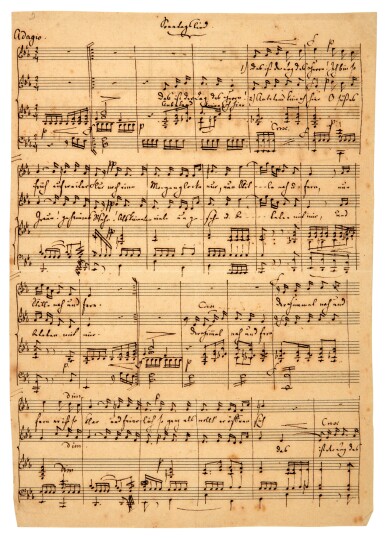AUTOGRAPH MANUSCRIPT FROM THE DRAFT OF HIS POEM 'I STOOD TIPTOE UPON A LITTLE HILL' [which Keats originally titled elsewhere 'Endymion'] with autograph revisions and deletions currente calamo preserving reconsidered readings, containing some 33 lines, comprising lines 157-172 with survivals of 173 and 174 on the recto and lines 181-192 and a cancelled version of lines 193-195 on the verso, pen trials at the head of the first side, c. 5 x 5 inches; 129 x 129 mm, lower portion of the fragment scissor cut on the bias, red morocco slip case, Dallas Pratt bookplate [1816] THIS IS THE ONLY POETICAL MANUSCRIPT BY KEATS NOW EVER LIKELY TO BE AVAILABLE TO COLLECTORS. IT IS ONLY ONE OF THREE substantial pieces of Keats's original draft of 'I stood Tiptoe upon a Little Hill' still in private hands -- THE OTHER TWO UNTRACED SINCE 1929 (A. Edward Newton Sale): the present manuscript is the only poetical draft by Keats to come on the market since the Newton Sale. In terms of what is known, it is unlikely that another poetical manuscript by Keats will be available to collectors in the foreseeable future, perhaps ever. Little of Keats's output remains in Britain. Garrod began his Preface to his second edition of The Poetical Works of John Keats over half a century ago: 'Today, most of the important MSS of Keats have their home in the United States of America...In this country we still keep (in the British Museum) the autograph Ms of Hyperion except one leaf now in New York]...the Notebook (also in the British Museum) into which Keats wrote The Pot of Basil and the Eve of St. Mark. In Hampstead, Keats House treasures scraps of Keats's handwriting. For the rest, what was written by Keats must be read in America.' [I repatriated the present manuscript from America in the early 1990s (RLD)]. Reconsidered readings, all recorded by Garrod, are preserved in this manuscript, as is a substantially different version of lines 189-192, which is also recorded by Garrod: Or slowly moves about the Heavens Where Where Had he been to catch a Thing so fair Into what Regions was his spirit gone When he first thought of thee Endymion?... The printed text for these lines reads: Full in the speculation of the stars. Ah! surely he had burst our mortal bars; Into some wond'rous region he had gone, To search for thee, divine Endymion Curiously, Garrod did not record eight of Keats's uses of capital letters in this manuscript. This manuscript was once in the possession of one of Keats's earliest and closest friends, Charles Cowden Clarke, who cut up the ten-leaf manuscript into thirteen pieces (of which this is one) containing twenty-two fragments of the poem (rectos and versos) as mementoes for the poet's admirers and friends. The locations of most of the twelve other pieces are institutions: Harvard, British Library, Pierpont Morgan Library, Berg Collection, Free Library of Philadelphia, and Scottish National Portrait Gallery. The whereabouts of the remaining two known pieces, formerly owned by Walter T. Spencer, has been long unknown. Four pieces have never been recorded since the manuscript was cut up. Keats had begun work on the poem before leaving Margate in July 1816, according to Leigh Hunt's biography of Lord Byron and Some of his Contemporaries that the poem was 'suggested [to Keats] by a delightful summer-day, as he stood beside the gate that leads from the Battery on Hampstead Heath into a field by Caen Wood.' This fragment (formerly in the estate of Dr Dallas Bache Pratt) shows Keats's fluency in evoking the pastoral scenes that typify his earliest verses. Hunt must have come by this information second-hand, as he did not meet Keats until the Autumn of 1816. Keats was preparing his first volume of poems that would be printed in March 1817 and was looking about for something attractive to follow the dedication to Leigh Hunt. 'I stood tiptoe' with its 'breathless catalogue of rural sights' (Bate) seemed appropriate. According to Bate, Keats resumed work on
AUTOGRAPH MANUSCRIPT FROM THE DRAFT OF HIS POEM 'I STOOD TIPTOE UPON A LITTLE HILL' [which Keats originally titled elsewhere 'Endymion'] with autograph revisions and deletions currente calamo preserving reconsidered readings, containing some 33 lines, comprising lines 157-172 with survivals of 173 and 174 on the recto and lines 181-192 and a cancelled version of lines 193-195 on the verso, pen trials at the head of the first side, c. 5 x 5 inches; 129 x 129 mm, lower portion of the fragment scissor cut on the bias, red morocco slip case, Dallas Pratt bookplate [1816] THIS IS THE ONLY POETICAL MANUSCRIPT BY KEATS NOW EVER LIKELY TO BE AVAILABLE TO COLLECTORS. IT IS ONLY ONE OF THREE substantial pieces of Keats's original draft of 'I stood Tiptoe upon a Little Hill' still in private hands -- THE OTHER TWO UNTRACED SINCE 1929 (A. Edward Newton Sale): the present manuscript is the only poetical draft by Keats to come on the market since the Newton Sale. In terms of what is known, it is unlikely that another poetical manuscript by Keats will be available to collectors in the foreseeable future, perhaps ever. Little of Keats's output remains in Britain. Garrod began his Preface to his second edition of The Poetical Works of John Keats over half a century ago: 'Today, most of the important MSS of Keats have their home in the United States of America...In this country we still keep (in the British Museum) the autograph Ms of Hyperion except one leaf now in New York]...the Notebook (also in the British Museum) into which Keats wrote The Pot of Basil and the Eve of St. Mark. In Hampstead, Keats House treasures scraps of Keats's handwriting. For the rest, what was written by Keats must be read in America.' [I repatriated the present manuscript from America in the early 1990s (RLD)]. Reconsidered readings, all recorded by Garrod, are preserved in this manuscript, as is a substantially different version of lines 189-192, which is also recorded by Garrod: Or slowly moves about the Heavens Where Where Had he been to catch a Thing so fair Into what Regions was his spirit gone When he first thought of thee Endymion?... The printed text for these lines reads: Full in the speculation of the stars. Ah! surely he had burst our mortal bars; Into some wond'rous region he had gone, To search for thee, divine Endymion Curiously, Garrod did not record eight of Keats's uses of capital letters in this manuscript. This manuscript was once in the possession of one of Keats's earliest and closest friends, Charles Cowden Clarke, who cut up the ten-leaf manuscript into thirteen pieces (of which this is one) containing twenty-two fragments of the poem (rectos and versos) as mementoes for the poet's admirers and friends. The locations of most of the twelve other pieces are institutions: Harvard, British Library, Pierpont Morgan Library, Berg Collection, Free Library of Philadelphia, and Scottish National Portrait Gallery. The whereabouts of the remaining two known pieces, formerly owned by Walter T. Spencer, has been long unknown. Four pieces have never been recorded since the manuscript was cut up. Keats had begun work on the poem before leaving Margate in July 1816, according to Leigh Hunt's biography of Lord Byron and Some of his Contemporaries that the poem was 'suggested [to Keats] by a delightful summer-day, as he stood beside the gate that leads from the Battery on Hampstead Heath into a field by Caen Wood.' This fragment (formerly in the estate of Dr Dallas Bache Pratt) shows Keats's fluency in evoking the pastoral scenes that typify his earliest verses. Hunt must have come by this information second-hand, as he did not meet Keats until the Autumn of 1816. Keats was preparing his first volume of poems that would be printed in March 1817 and was looking about for something attractive to follow the dedication to Leigh Hunt. 'I stood tiptoe' with its 'breathless catalogue of rural sights' (Bate) seemed appropriate. According to Bate, Keats resumed work on













Try LotSearch and its premium features for 7 days - without any costs!
Be notified automatically about new items in upcoming auctions.
Create an alert